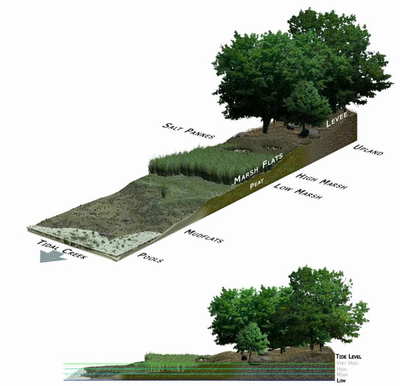Estuaries: Where the Ocean Meets Fresh Water
Estuaries form a unique marine biome that occurs where a source of fresh water, such as a river, meets the ocean. Therefore, both fresh water and salt water are found in the same vicinity. Mixing results in a diluted (brackish) saltwater. Estuaries form protected areas where many of the young offspring of crustaceans, mollusks, and fish begin their lives. Salinity of estuaries is a very important factor that influences the organisms found there and their adaptations. The salinity, which varies, is based on the rate of flow of its freshwater sources. Once or twice a day, high tides bring salt water into the estuary. Low tides, occurring at the same frequency, reverse the current of salt water .
Estuary: Chesapeake Bay, Eastern Shore, Virginia, USA
The short-term and rapid variation in salinity due to the mixing of fresh water and salt water is a difficult physiological challenge for the plants and animals that inhabit estuaries. Many estuarine plant species are halophytes: plants that can tolerate salty water on their roots or sea spray. In some halophytes, filters in the roots remove the salt from the water that the plant absorbs. Other plants are able to pump oxygen into their roots. Animals, such as mussels and clams, have developed behavioral adaptations that expend a lot of energy to function in this rapidly changing environment. When these animals are exposed to low salinity, they stop feeding, close their shells, and switch from aerobic respiration (in which they use gills) to anaerobic respiration (a process that does not require oxygen). When high tide returns to the estuary, the salinity and oxygen content of the water increases, causing these animals to open their shells, begin feeding, and to return to aerobic respiration.
Estuaries provide habitats for a large number of organisms and support very high productivity. Estuaries provide habitats for many fish nurseries, depending upon their locations in the world, such as salmon and sea trout. Also, migratory bird populations make essential use of estuaries.
Many species of fish and invertebrates have various methods to control or conform to the shifts in salt concentrations and are termed osmoconformers and osmoregulators. Many animals also burrow to avoid predation and to live in the more stable sedimental environment. However, large numbers of bacteria are found within the sediment which have a very high oxygen demand. This reduces the levels of oxygen within the sediment often resulting in partially anoxic conditions, which can be further exacerbated by limited water flux.
Phytoplankton are key primary producers in estuaries. They move with the water bodies and can be flushed in and out with the tides. Their productivity is largely dependent upon the turbidity of the water. The main phytoplankton present are diatoms and dinoflagellates which are abundant in the sediment.
Salt Marsh
A salt marsh or saltmarsh, also known as a coastal salt marsh or a tidal marsh, is a coastal ecosystem in the upper coastal intertidal zone between land and open salt water or brackish water that is regularly flooded by the tides. It is dominated by dense stands of salt-tolerant plants such as herbs, grasses, or low shrubs. These plants are terrestrial in origin and are essential to the stability of the salt marsh in trapping and binding sediments. Salt marshes play a large role in the aquatic food web and the delivery of nutrients to coastal waters. They also support terrestrial animals and provide coastal protection.

Animation showing high and low tides
Salt marsh showing salt pannes and pools during low tide, mean low tide, high tide and very high tide (spring tide).
Coastal salt marshes can be distinguished from terrestrial habitats by the daily tidal flow that occurs and continuously floods the area. It is an important process in delivering sediments, nutrients and plant water supply to the marsh. At higher elevations in the upper marsh zone, there is much less tidal inflow, resulting in lower salinity levels. Soil salinity in the lower marsh zone is fairly constant due to everyday annual tidal flow. However, in the upper marsh, variability in salinity is shown as a result of less frequent flooding and climate variations. Rainfall can reduce salinity and evapotranspiration can increase levels during dry periods. As a result, there are microhabitats populated by different species of flora and fauna dependant on their physiological abilities.
Marsh Bride Brook and Coastal Salt Marsh, East Lyme, Connecticut, USA
Plant species diversity is relatively low, since the flora must be tolerant of salt, complete or partial submersion, and anoxic mud substrate. The most common salt marsh plants are glassworts (Salicornia spp.) and the cordgrass (Spartina spp.), which have worldwide distribution. They are often the first plants to take hold in a mudflat and begin its ecological succession into a salt marsh. Their shoots lift the main flow of the tide above the mud surface while their roots spread into the substrate and stabilize the sticky mud and carry oxygen into it so that other plants can establish themselves as well. Plants such as sea lavenders (Limonium spp.), plantains (Plantago spp.), and varied sedges and rushes grow once the mud has been vegetated by the pioneer species.
Salt marshes are quite photosynthetically active and are extremely productive habitats. They serve as depositories for a large amount of organic matter and are full of decomposition, which feeds a broad food chain of organisms from bacteria to mammals. Many of the halophytic plants such as cordgrass are not grazed at all by higher animals but die off and decompose to become food for micro-organisms, which in turn become food for fish and birds.